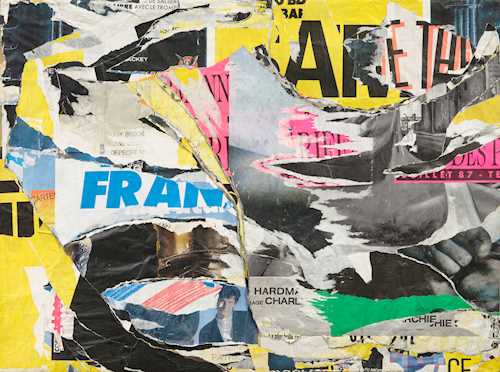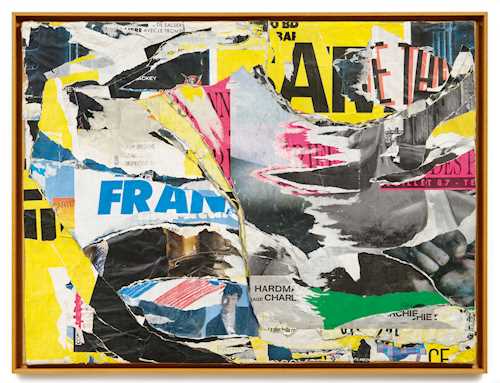
拍品 3446 - A207 战后和当代 - Donnerstag, 30. November 2023, 02.00 PM
JACQUES VILLEGLÉ (JACQUES MAHÉ DE LA VILLEGLÉ)
(Quimper 1926–2022 Paris)
52, boulevard de Sébastopol. 1987.
Décollage on canvas.
Signed lower right: Villeglé, as well as inscribed top centre: 52 Sébastopol, and signed, titled, dated and with measurements on the reverse: Villeglé 52 bd de Sébastopol 20 juillet 1987 89,5 × 119.
89.5 × 119 cm.
Gutachten:
[Art.ArtText.Text@@5('[Art.BoId],21')]
[Art.ArtText.Text@@5('[Art.BoId],21')]
Provenienz:
[Art.ArtText.Text@@5('[Art.BoId],22')]
[Art.ArtText.Text@@5('[Art.BoId],22')]
Ausstellungen:
[Art.ArtText.Text@@5('[Art.BoId],23')]
[Art.ArtText.Text@@5('[Art.BoId],23')]
Ausstellung:
[Art.ArtText.Text@@5('[Art.BoId],24')]
[Art.ArtText.Text@@5('[Art.BoId],24')]
Literatur:
[Art.ArtText.Text@@5('[Art.BoId],25')]
[Art.ArtText.Text@@5('[Art.BoId],25')]
[Art.ArtText.Text@@5('[Art.BoId],26')]
With the certificate by the artist, 30 April 2009, Paris.
Provenance:
- Vecchiato New Art Galleries, Padua.
- Purchased from the above by the present owner in 2017, since then private collection Switzerland.
"My art is a whole repertoire of cracks, scratches, abrasions, scribbles, daubings, furrows, abrasions, inscriptions and pasting over." Jacques Villeglé
The French artist Jacques Mahé de La Villeglé, known as Jacques Villeglé, was born in Quimper in 1926. In 1946 he graduated in art and architecture from the École des Beaux-Arts in Rennes, after which he studied architecture at the École Nationale Supérieure des Beaux-Arts in Rennes.
Already during his time as a student, Villeglé began to collect objects left behind from the war. He assembled pieces of metal, steel and wall remnants, as well as debris from the Atlantic Wall in Saint-Malo to make sculptures. He created his first series of works, the "Objets trouvés", together with his student friend Raymond Hains. They are in the tradition of Marcel Duchamp's "Readymades" and are to be understood as a record of traces of contemporary civilisation. They proceeded in the same way with the torn posters, which they removed from their mounts on the street walls in order to transform them into new works on canvas. In 1949, the friends founded the "Poster Designers" and proclaimed the "guerrilla movement of signs". They first called their art "affiches lacérées" (torn posters) and later "décollage". Often their works have an explicitly political dimension. At that time, the titles of the works came from the word fragments that could be read on the torn off elements. They ended their collaboration in the mid-1950s.
The present work is named after Boulevard de Sébastopol in Paris, which is one of the most important thoroughfares crossing the centre of the city, replacing Rue Saint-Denis and Rue Saint-Martin in particular. Number 52 on this road, which is over 1300m long, is located in the middle of the transition between the 3rd and 4th arrondissements, a stone's throw from the Centre Pompidou and in the immediate vicinity of the lively Marais district. In this work, too, Villeglé adopts the stance of the flâneur. Yet again, he succeeds, playfully, in bringing out the beauty hidden within the layers of paper torn by anonymous hands, out of the urban chaos. His canvases transport the viewer back into the history of the streets of Paris, interpreting and narrating the collective realities of the past.
Provenance:
- Vecchiato New Art Galleries, Padua.
- Purchased from the above by the present owner in 2017, since then private collection Switzerland.
"My art is a whole repertoire of cracks, scratches, abrasions, scribbles, daubings, furrows, abrasions, inscriptions and pasting over." Jacques Villeglé
The French artist Jacques Mahé de La Villeglé, known as Jacques Villeglé, was born in Quimper in 1926. In 1946 he graduated in art and architecture from the École des Beaux-Arts in Rennes, after which he studied architecture at the École Nationale Supérieure des Beaux-Arts in Rennes.
Already during his time as a student, Villeglé began to collect objects left behind from the war. He assembled pieces of metal, steel and wall remnants, as well as debris from the Atlantic Wall in Saint-Malo to make sculptures. He created his first series of works, the "Objets trouvés", together with his student friend Raymond Hains. They are in the tradition of Marcel Duchamp's "Readymades" and are to be understood as a record of traces of contemporary civilisation. They proceeded in the same way with the torn posters, which they removed from their mounts on the street walls in order to transform them into new works on canvas. In 1949, the friends founded the "Poster Designers" and proclaimed the "guerrilla movement of signs". They first called their art "affiches lacérées" (torn posters) and later "décollage". Often their works have an explicitly political dimension. At that time, the titles of the works came from the word fragments that could be read on the torn off elements. They ended their collaboration in the mid-1950s.
The present work is named after Boulevard de Sébastopol in Paris, which is one of the most important thoroughfares crossing the centre of the city, replacing Rue Saint-Denis and Rue Saint-Martin in particular. Number 52 on this road, which is over 1300m long, is located in the middle of the transition between the 3rd and 4th arrondissements, a stone's throw from the Centre Pompidou and in the immediate vicinity of the lively Marais district. In this work, too, Villeglé adopts the stance of the flâneur. Yet again, he succeeds, playfully, in bringing out the beauty hidden within the layers of paper torn by anonymous hands, out of the urban chaos. His canvases transport the viewer back into the history of the streets of Paris, interpreting and narrating the collective realities of the past.
CHF 15 000 / 20 000 | (€ 15 460 / 20 620)
以瑞士法郎銷售 CHF 18 750 (包含買家佣金)
所有信息随时可能更改。


